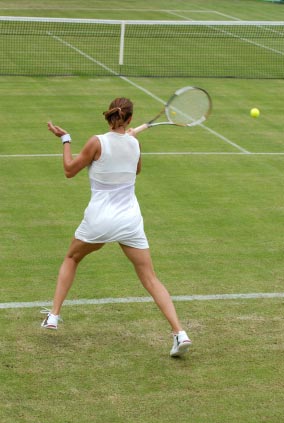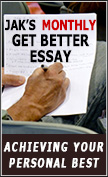November 2010:
THE MOST NEGLECTED SHOT IN THE GAME
Q. What’s the most ignored shot, in terms of practice time devoted to it, in tennis?
A. The return of serve. Since it’s second in importance behind the serve regarding getting the ball in play, and arguably number two in the difficulty department as well, this is very curious. And, even the pre-match warm-up provides very limited return practice if you follow protocol – at the tour level it is rare that anyone will even attempt it, preferring instead to concentrate on their serves.
 Although still a forehand or backhand, it is differentiated from in the point ground strokes hit on the run because it is launched from a static start. Not easy!
Although still a forehand or backhand, it is differentiated from in the point ground strokes hit on the run because it is launched from a static start. Not easy!
Because it is a static start shot, developing, at least at first, a consciously repeatable ritual – exactly the same each and every time - that will eventually morph into becoming as automatic and unconscious as walking, is enormously important. So many players, either unenlightened or complacent or both, arrive at their chosen return position with nothing in mind, and then stand there motionless imitating a mannequin at Macy’s. Not good!
After a receiving game point is completed make it a point to inhale and exhale deeply and quiet your mind for a few seconds. Then visualize your flight plan for your next return – one for both the forehand and backhand wing - and release any telltale tension in your jaw, neck, shoulders, and arms and hands while you make your way slowly and methodically to the next receiving position. Since there’s nothing worse than allowing yourself to be quick served, either intentionally or unintentionally, always approach your chosen spot from well behind the baseline while facing the server. Walk well past the baseline if you’re coming from the court proper. If necessary, once you’ve turned around wave off any server rushing you with your hand up until you’ve had time to completely settle in.
Once there, re-energize as necessary by laterally skipping side-to-side, foot-to-foot, followed by the ritual stage typically consisting of a slow and easy side-to-side swaying back and forth of the racket and shoulders. This will enhance both relaxation and rhythm prior to the initial take-back-turn-pivot that’s completed by the time the ball is passing over the net, albeit softly, versus a solid serve once the split step is landed at the server’s impact. And you’d better have a well timed split step if you’re going to be the receiver you’re capable of being.
Now footwork becomes crucial and is fully engaged in either chasing down a serve that stretches you out wide or into the center of the court, or through stutter-stepping, those small, rapid fire adjustment steps that keep you connected and in synch with serves right into your strike zone or ones that are jamming you.
Nonetheless, solid, reliable returning isn’t going to happen without exceptionalball tracking, beginning at impact, to the service box bounce point – a common place to “lose it,” and finally into the hitting zone in front of your body where you intend to strike it based upon your pre-visualized shot selection.
During this always the same sequence of events, from approaching your position, to settling in, to serve recognition, and up to the moment of ball-on-racket impact, your head must remain very still if you’re going to see the ball well. Bobble-heading, or lifting your head up and back as you’re striking the ball, minimally guarantees return misdirection and often causes completely shanked mishits. No possibilities at all!
Returning serve is ultimately about timing through both eye-hand and eye-foot coordination working in tandem – the elusive right place, right time. Teaming up with the approaching ball, working with it versus fighting it, supports the physical components of smoothness versus lunging or jerking at the ball, and also promotes a positive and comfortable mindset that will produce your best results.
Need a model? There is no one better at preparing to return serve than Serena Williams. Her ritual from a point’s end leads up to, and is aimed at, a perfectly timed total focus on the ball and its intended outcome, with clearly nothing else entering the picture. Her beautifully managed tabula rasa moment. Wow!
I’ll leave you with a reminder of a return dynamic that you experience periodically. The ball is served. It appears as if it’s on track to be in. You ready yourself. You start your racket at the ball, but, at the very last moment you realize that it’s just out and you, physically unable to stop the racket but with any pressure suddenly eliminated, completely relax and go through with the return. The result? Almost always a mind boggling, perfectly timed, silky smooth, and effortlessly powerful shot with a GPS-like guided result!
Think about that!
Questions and comments are welcome at anytime for all tips present and past via email.
This Tip of the Month is copyright© by Jak Beardsworth Tennis. All rights reserved. Copies may be made only with the permission of and by Jak Beardsworth. Contact him here.
Tips Archive
- May, June, 2013 JUST TALKING HEADS OR MORE [read more]
- March, April, 2013 SELF-TALK: Good, Bad, or Indifferent [read more]
- January, February, 2013 BOOK-A-MILLION: Do Tennis Players Read? [read more]
- December, 2012 THE KEY TO TOUR LEVEL BALL STRIKING: And How to Learn It [read more]
- November, 2012 ARE YOU A THUDDER, A TWANGER, OR A PINGER: Racket Dampeners [read more]
- September, October, 2012 SMART SHOTS [read more]
- July, August, 2012 TEN TOP STRESS REDUCERS [read more]
- June, 2012 MAKING YOUR LESSONS STICK [read more]
- May, 2012 THE IMPOSSIBLE: Accelerating and Decelerating Simultaneously [read more]
- April, 2012 PLAYER DISCONNECTION [read more]
- March, 2012 BENDING THE SERVE IN [read more]
- February, 2012 UNDERSTANDING TERMINOLOGY: Drill vs Clinic vs Team Practice [read more]
- January, 2012 PLAYING SCARED? [read more]
- December, 2011 CUTTING OFF THE ANGLE…VERTICALLY [read more]
- November, 2011 WHY COACHING? [read more]
- October, 2011 THE EASY BALLS ARE NOT EASY [read more]
- August/September, 2011 NEVER TOO LATE FOR OLDER DOGS [read more]
- June/July, 2011 HARD COURTS, SOFT COURTS, and YOUR BODY'S ADAPTATION [read more]
- April/May, 2011 JAW DROPPNG [read more]
- March, 2011 CLUB DOUBLES' INCREASINGLY MISSING LINK [read more]
- February, 2011 TIP 2 | POOH POOHING DOUBLES STRATEGY SESSIONS [read more]
- February, 2011 TIP 1 | CLAY TO HARD, HARD TO CLAY [read more]
- January, 2011 ICING THE SERVER WHEN RECEIVING IN THE BIG MOMENTS [read more]
- December, 2010 JOHN ISNER’S “GOOD MISS” [read more]
- November, 2010 THE MOST NEGLECTED SHOT IN THE GAME [read more]
- October, 2010 BALL BOUNCING and the SERVE [read more]
- September, 2010 TAKE YOUR EYE OFF THE BALL [read more]
- July-August, 2010 SUMMER SCHOOL COURTSIDE CRIB SHEET [read more]
- May-June, 2010 THE 2-HANDED JUMP BACKHAND: The Dumbest Shot in Tennis [read more]
- April, 2010 THE STANDING AROUND SYNDROME [read more]
- March, 2010 THE ELUSIVE SERVICE TOSS [read more]
- February, 2010 PREPARING TO START THE POINT: Serving and Receiving [read more]
- January, 2010 DEBUNKING THE MODERN GAME [read more]
- December, 2009 RELAX – IT'S JUST A RALLY BALL [read more]
- November, 2009 DEFEATING THE POACHER [read more]
- October, 2009 PRACTICE, PRACTICE, PRACTICE [read more]
- September, 2009 SERVING SUCCESS: Warming-Up vs Match Play [read more]
- August, 2009 THE SPLIT STEP: Defending the Court, Rushing the Net, and More [read more]
- July, 2009 THE THIRD GROUNDSTROKE [read more]
- June, 2009 HOW MANY HANDS DOES IT TAKE? [read more]
- May, 2009 THE MOST IMPORTANT SKILL [read more]
- April, 2009 PLAYING IN THE FLORIDA WIND [read more]
- March, 2009 Letting them Play for Peak Performance in Clubland [read more]
- February, 2009 SUPPORTING YOUR GAME [read more]
- January, 2009 RESPECTING THE GAME: Top 10 Do's & Don'ts [read more]
- December, 2008 Getting the Warm-up Right [read more]
- November, 2008 Visualize...Realize: The Mind Body Connection [read more]
- October, 2008 Reading Their Mail [read more]


